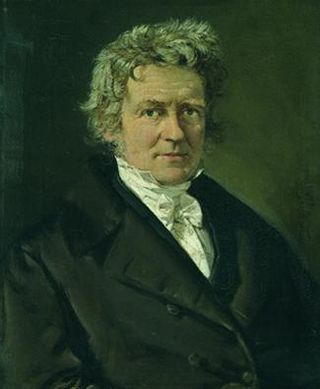
Friedrich Wilhelm Bessel was a German astronomer, mathematician, physicist, and geodesist. He was the first astronomer who determined reliable values for the distance from the sun to another star by the method of parallax. Certain important mathematical functions were named Bessel functions after Bessel's death, though they had originally been discovered by Daniel Bernoulli before being generalised by Bessel.
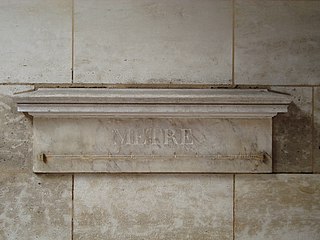
The metre is the base unit of length in the International System of Units (SI). Since 2019, the metre has been defined as the length of the path travelled by light in vacuum during a time interval of 1/299792458 of a second, where the second is defined by a hyperfine transition frequency of caesium.

Metrication or metrification is the act or process of converting to the metric system of measurement. All over the world, countries have transitioned from local and traditional units of measurement to the metric system. This process began in France during the 1790s, and has persistently advanced over two centuries, accumulating into 95% of the world officially only using the modern metric system. Nonetheless, this also highlights that certain countries and sectors are either still transitioning or have chosen not to fully adopt the metric system.
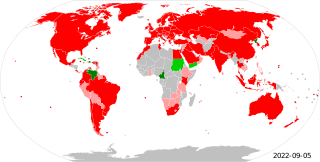
The Metre Convention, also known as the Treaty of the Metre, is an international treaty that was signed in Paris on 20 May 1875 by representatives of 17 nations: Argentina, Austria-Hungary, Belgium, Brazil, Denmark, France, Germany, Italy, Peru, Portugal, Russia, Spain, Sweden and Norway, Switzerland, Ottoman Empire, United States of America, and Venezuela.

Jean-Charles, chevalier de Borda was a French mathematician, physicist, and Navy officer.
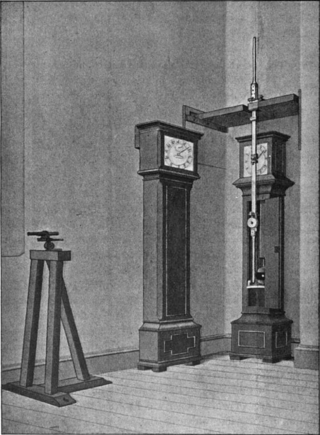
A Kater's pendulum is a reversible free swinging pendulum invented by British physicist and army captain Henry Kater in 1817, published 29th January 1818 for use as a gravimeter instrument to measure the local acceleration of gravity. Its advantage is that, unlike previous pendulum gravimeters, the pendulum's centre of gravity and center of oscillation do not have to be determined, allowing a greater accuracy. For about a century, until the 1930s, Kater's pendulum and its various refinements remained the standard method for measuring the strength of the Earth's gravity during geodetic surveys. It is now used only for demonstrating pendulum principles.

The history of geodesy (/dʒiːˈɒdɪsi/) began during antiquity and ultimately blossomed during the Age of Enlightenment.
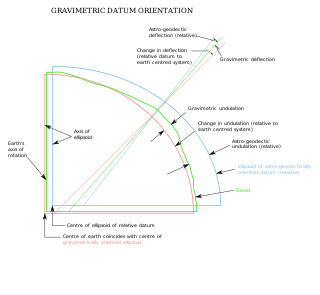
The vertical deflection (VD) or deflection of the vertical (DoV), also known as deflection of the plumb line and astro-geodetic deflection, is a measure of how far the gravity direction at a given point of interest is rotated by local mass anomalies such as nearby mountains. They are widely used in geodesy, for surveying networks and for geophysical purposes.
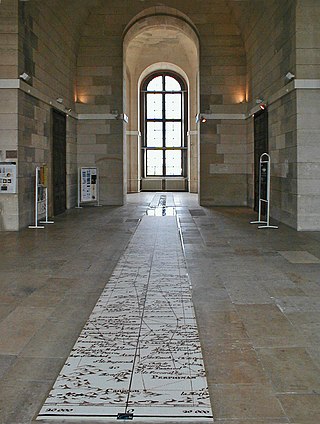
The Paris meridian is a meridian line running through the Paris Observatory in Paris, France – now longitude 2°20′14.02500″ East. It was a long-standing rival to the Greenwich meridian as the prime meridian of the world. The "Paris meridian arc" or "French meridian arc" is the name of the meridian arc measured along the Paris meridian.
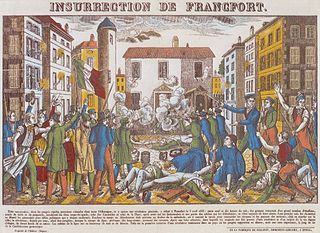
The Frankfurter Wachensturm on 3 April 1833 was a failed attempt to start a revolution in Germany.
Friedrich Hopfner was an Austrian geodesist, geophysicist and planetary scientist.
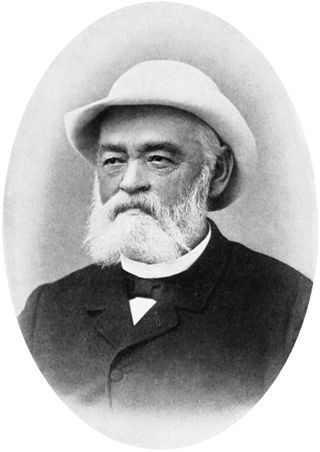
Alexander Spengler was a Swiss physician of German origin and the first physician specializing in tuberculosis in Davos.
The Bessel ellipsoid is an important reference ellipsoid of geodesy. It is currently used by several countries for their national geodetic surveys, but will be replaced in the next decades by modern ellipsoids of satellite geodesy.
1556 Wingolfia, provisional designation 1942 AA, is a metallic asteroid from the outer regions of the asteroid belt, approximately 30 kilometers in diameter. It was discovered by German astronomer Karl Reinmuth at the Heidelberg-Königstuhl State Observatory on 14 January 1942. The asteroid was named after Wingolf, a student fraternity in Heidelberg.
The International Association of Geodesy (IAG) is a constituent association of the International Union of Geodesy and Geophysics focusing on the science which measures and describes the Earth's shape, its rotation and gravity field.

The history of the metre starts with the Scientific Revolution that is considered to have begun with Nicolaus Copernicus's publication of De revolutionibus orbium coelestium in 1543. Increasingly accurate measurements were required, and scientists looked for measures that were universal and could be based on natural phenomena rather than royal decree or physical prototypes. Rather than the various complex systems of subdivision then in use, they also preferred a decimal system to ease their calculations.
Ismail Mustafa, Ismail Effendi Mustafa,Ismail Bey Mustapha, Ismail Mustafa al-Falaki or Ismail Pasha al-Falaki was an Egyptian astronomer and mathematician. Effendi, Bey and Pasha corresponded to the different ranks he attained along his career; "al-Falaki" was added to his name literally meaning "the astronomer". He was born in Cairo to a family of Turkish origin and was educated in Paris, France.

Emile Plantamour or Émile Plantamour was a Swiss astronomer.

Carlos Ibáñez e Ibáñez de Ibero, 1st Marquis of Mulhacén, was a Spanish divisional general and geodesist. He represented Spain at the 1875 Conference of the Metre Convention and was the first president of the International Committee for Weights and Measures. As a forerunner geodesist and president of the International Geodetic Association, he played a leading role in the worldwide dissemination of the metric system. His activities resulted in the distribution of a platinum and iridium prototype of the metre to all States parties to the Metre Convention during the first meeting of the General Conference on Weights and Measures in 1889. These prototypes defined the metre right up until 1960.

Immo Appenzeller is a German astronomer.















